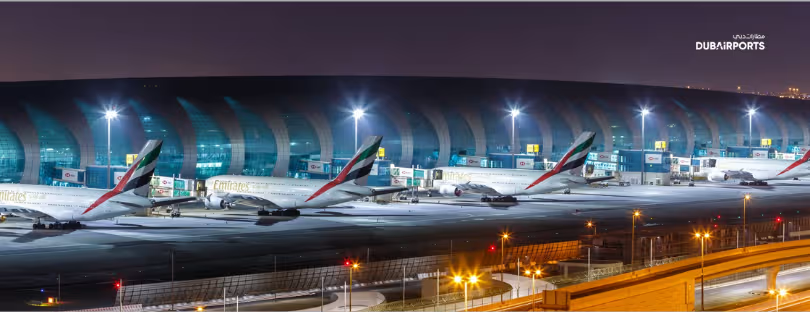
Dubai Airports Brings AI to the Heart of Airport Operations
Dubai International (DXB) is stepping deeper into real-time, data-driven airport operations—and this time, it’s happening right on the apron. Dubai Airports has partnered with Assaia, a Swiss aviation AI specialist, to deploy an AI-powered turnaround management system across all DXB aircraft stands. The goal? Sharper situational awareness, tighter coordination, and fewer delays at the world’s busiest international airport.
If you’ve been following how airports are evolving, you’ll know that turnaround—the window between an aircraft’s arrival and its departure—is one of the toughest operational puzzles in aviation. One small delay in refuelling, catering, or baggage offload can ripple across the day’s schedule. DXB’s new initiative aims to eliminate precisely those friction points using computer vision and predictive AI.
Emirates Becomes the First Airline Globally With Full-Scale AI Turnaround
A big part of this story is Emirates. With this rollout, Emirates becomes the only airline in the world operating a fully AI-enabled turnaround management system across its entire DXB operation. That’s a bold milestone — and a reflection of the airline’s wider shift towards precision operations powered by real-time intelligence.
Dubai Airports says this project aligns with its long-term strategy: using advanced analytics and machine learning to make operations more predictable, especially as DXB moves toward handling well over 90 million passengers annually.
Majed Al Joker, COO at Dubai Airports, put it simply: innovation here isn’t for the sake of novelty—it’s to “build smarter, scalable systems” that prepare DXB for the future of global travel. And with the airport’s growth trajectory, scalable is the keyword.
How the New AI System Works on the Apron
Assaia’s platform uses apron-mounted cameras and AI models to monitor everything happening around the aircraft. Think of it as an always-on operations analyst watching every step of the turnaround: when the chocks are placed, when the jet bridge aligns, when refuelling starts, when bags begin to flow.
Instead of relying on manual logs or radio calls, the system generates real-time alerts and predicts potential delays before they actually occur. That matters because a five-minute heads-up can be the difference between an on-time departure and a missed slot.
And it’s not just for Emirates. The system is expected to improve workflows for flydubai, dnata, and all the ground service providers forming the DXB ecosystem. In a complex hub operation, shared visibility is often half the solution.
Nick Moore of Emirates highlighted that this AI layer should significantly reduce ground-related delays and help achieve tighter, more reliable turnaround times—something passengers definitely feel when connecting through Dubai.
AI Turnaround Management Is Already Taking Off Globally
If all this sounds futuristic, it really isn’t. Assaia’s technology is already operational at some of the world’s major airports, including Toronto Pearson, New York JFK’s Terminal 4, Rome Fiumicino, and Seattle-Tacoma. DXB is the latest—but easily the most strategically significant—addition to that list.
Why significant? DXB is the world’s busiest international airport, operating one of the most complex transfer networks globally. What works here tends to inspire the rest of the industry.
Jan Willem Kappes, CCO at Assaia, describes the collaboration as a major step toward an “efficient, connected, and passenger-focused” aviation future. And he isn’t exaggerating—DXB provides a global testbed for what AI-driven airport operations can look like at scale.
DXB’s Wider Digital Transformation Momentum
This new system sits alongside Dubai’s broader digital transformation efforts, which range from biometric immigration to smart baggage systems and AI-enabled resource planning. Dubai’s aviation strategy increasingly leans on automation and predictive analytics — especially as the emirate prepares for the expansion of Al Maktoum International (DWC), supported by the recently announced US$3.5 billion Expression of Interest from UK Export Finance.
As the region positions itself as a global aviation hub for the coming decades, these kinds of upgrades aren’t optional — they’re foundational.
Conclusion: Dubai Airports’ AI Leap Puts Pressure on Global Competitors
AI-driven turnaround management is becoming one of the most competitive battlegrounds in airport operations. Players like Synaptic Aviation in the US, Aurrigo in the UK, and Wipro’s aviation AI suite have already been trialed at major hubs — yet none operates at the scale now being deployed at DXB. That’s the part worth watching.
Dubai’s move sets a new benchmark: a fully AI-enabled apron operation across all stands, integrated with the airport’s dominant airline and its ground handlers. Few global hubs — not Heathrow, not Frankfurt, not Singapore Changi—are operating at this level yet. According to IATA’s recent “Future of Operations” briefings and ACI World’s 2024 Airport Technology Outlook, AI-powered apron management is expected to become standard within the decade. DXB is simply getting there first.
For travelers, the impact is subtle but meaningful: better on-time performance, smoother connections, and fewer apron delays. For the industry, though, this marks a shift in expectations. Airports won’t just need more staff or more gates—they’ll need more intelligence. And Dubai, as usual, is showing that the future of global aviation will be built on data as much as on infrastructure.









